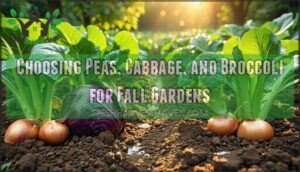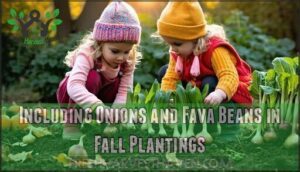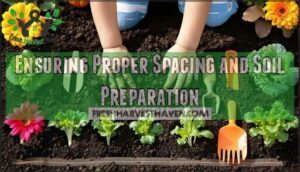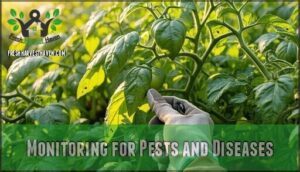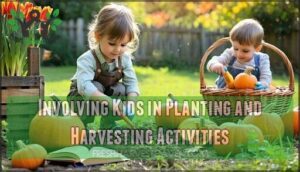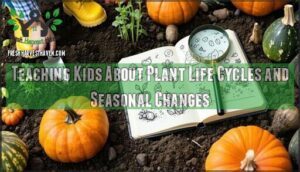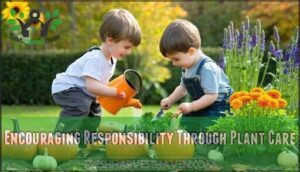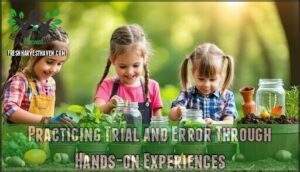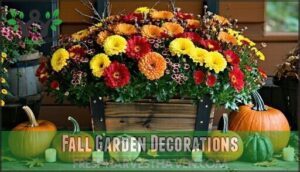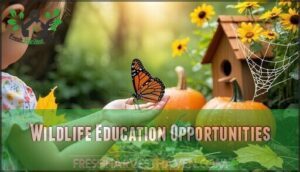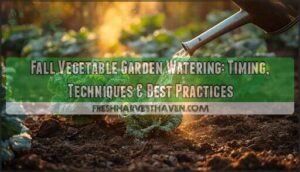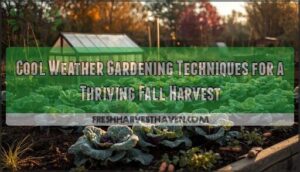This site is supported by our readers. We may earn a commission, at no cost to you, if you purchase through links.
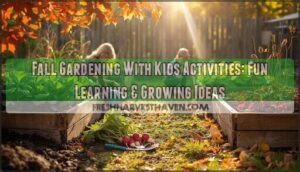
You’ll find cooler temperatures make working outside more comfortable, while fast-growing crops like radishes and lettuce keep kids engaged without testing their patience.
Plant cool-season vegetables such as peas, kale, and fava beans together, teaching responsibility through daily watering and care.
Beyond planting, involve children in preparing garden beds, collecting seeds from spent flowers, and searching for chrysalises hidden in dried stalks.
These autumn adventures naturally spark conversations about seasonal cycles and wildlife behavior, creating memories that stick long after the last harvest.
Table Of Contents
- Key Takeaways
- Fall Garden Preparation
- Planting Cool Season Crops
- Kid Friendly Gardening Activities
- Fall Garden Decorations
- Wildlife Education Opportunities
- Frequently Asked Questions (FAQs)
- What are some fun fall garden activities for kids?
- What do you do in a fall garden?
- What are some fun gardening activities for kids?
- What can kids learn in the garden?
- Are gardening activities for kids a good idea?
- How to start a garden with a child?
- What is the gardening 3 year rule?
- What should I be doing in my garden in the fall?
- What can you do in the garden in the fall?
- How to teach kids about gardening?
- Conclusion
Key Takeaways
- Plant fast-growing cool-season crops like radishes, lettuce, and peas to keep kids engaged – they’ll see results in days rather than weeks, maintaining their interest throughout the season.
- Transform garden chores into educational adventures by having kids hunt for "tired" plants, collect seeds from healthy specimens, and create compost bins – they’ll learn responsibility while having fun.
- Use fall’s cooler weather as a natural classroom for teaching plant life cycles, seasonal changes, and wildlife behavior through hands-on observation and garden journaling activities.
- Combine gardening with wildlife education by installing bird feeders, searching for beneficial insects, and observing how animals prepare for winter – creating lasting memories while building environmental awareness.
Fall Garden Preparation
Fall preparation transforms your garden into a learning playground where kids can get their hands dirty while mastering essential gardening skills.
You’ll clear spent plants, collect seeds, and prep beds together, turning cleanup into an exciting treasure hunt that sets the stage for next year’s growing adventures.
Pulling Up Non-producing Vegetables and Annuals
Regularly pulling up nonproducing vegetables and annuals transforms your fall gardening kids activities into valuable learning experiences. This autumn garden project teaches children about identifying spent plants while boosting soil health through proper garden cleanup tasks.
Turn this chore into an adventure by having kids hunt for "tired" plants that have stopped producing. It’s like being plant detectives! This gardening with children activity prevents diseases from overwintering in your beds. Using the garden cleanup tools will make the task easier.
- Look for yellowing, wilted, or frost-damaged plants together
- Teach kids which plants can be composted versus trashed
- Show them how healthy soil looks after cleanup
- Let children pull smaller plants while you handle larger ones
- Discuss how removing old plants makes room for new growth
Raking Leaves to Prepare Garden Beds
Once you’ve cleared spent plants, turn raking leaves into garden bed prep magic.
Show kids how leaf decomposition creates natural soil enrichment while you gather materials for composting leaves.
Make raking fun by creating leaf pile competitions, then use these treasures as mulch benefits for winter protection and spring nutrition in your fall gardening kids adventure.
Collecting Seeds for Spring Planting
Once you’ve finished raking, it’s time to collect seeds from your healthiest plants for next year’s garden.
Seed saving teaches kids about plant life cycles while building excitement for spring planting.
Choose seeds from your strongest, disease-free plants for the best seed viability.
Show kids how to properly dry and store seeds in labeled envelopes – they’ll love being "seed detectives" hunting for the perfect specimens.
Here are key seed collection tips:
- Select mature seed pods that are dry and brown on the plant
- Avoid hybrid seeds since they won’t grow true to the parent plant
- Test seed viability by placing a few in damp paper towels
- Start seed sharing exchanges with neighbors and friends.
This hands-on seed selection activity connects kids to the garden’s future while teaching patience and planning skills.
Consider using specialized seed containers for ideal preservation.
Removing Debris to Prevent Pests and Diseases
Once you’ve collected your seeds, it’s time for fall garden cleanup. Removing debris isn’t just about tidiness—it’s your best defense against pests and diseases that love to overwinter in garden mess.
One key step is preventing black spot on roses by removing affected leaves. This is crucial for maintaining a healthy garden environment.
- Clear out diseased plants to stop problems from spreading next season
- Remove fallen leaves that harbor fungal spores and pest eggs
- Pull weeds before they set seed and multiply your spring workload
Garden sanitation keeps your soil healthy and gives beneficial insects better habitat. Kids love this "detective work," hunting down hiding spots where pests might lurk, which makes it a fun and educational activity for the whole family.
Planting Cool Season Crops
Now you’ll select the perfect cool-season vegetables that thrive in fall’s cooler temperatures and shorter days.
These hardy plants, including peas, cabbage, broccoli, onions, and fava beans, actually prefer the crisp autumn weather over summer’s intense heat, and are considered hardy plants.
Choosing Peas, Cabbage, and Broccoli for Fall Gardens
Once your garden beds are ready, selecting the right cool-season varieties becomes your next adventure.
Brassicas like cabbage and broccoli love autumn’s crisp temperatures, while peas thrive when soil temperatures drop below 75°F.
Test your soil pH between 6.0-7.0 for ideal growth.
These crops need consistent watering needs and benefit from companion planting with onions.
Smart pest control involves spacing plants properly—peas need 1-2 inches, cabbage requires 18-24 inches, and broccoli needs 16-20 inches for healthy development.
Including Onions and Fava Beans in Fall Plantings
Fall power-duos like onions and fava beans bring serious Onion Benefits and Fava Nutrition to your garden adventure.
These fall vegetables excel at Soil Enrichment through nitrogen fixation, while onions’ natural Winter Hardiness makes them perfect fall planting kids can manage.
Companion Planting these crops teaches patience—fava beans germinate quickly, keeping young gardeners engaged, while onions develop slowly underground.
Both crops support beneficial insects and suppress weeds, creating ideal kids gardening activities that demonstrate how plants work together naturally in thriving fall gardens.
Ensuring Proper Spacing and Soil Preparation
Proper soil preparation transforms your fall garden into a thriving haven for young plants.
Mix soil amendments like compost into garden beds—kids love getting their hands dirty while creating nutrient-rich growing medium.
Teach spacing benefits by having children measure distances between plants using rulers or their hands. Root development depends on adequate room to grow, preventing overcrowding that stunts plants.
These kid friendly gardening activities make seasonal planting educational and fun, turning fall garden preparation into memorable learning experiences for the whole family.
Monitoring for Pests and Diseases
Keep watch for tiny troublemakers that can damage your fall garden. Pest identification turns into exciting bug hunting activities kids love, while teaching valuable insect behavior lessons.
Show children how natural predators like ladybugs protect plants. Practice disease prevention through proper garden hygiene by removing damaged leaves promptly.
- Check plants daily for aphids, snails, and other common pests
- Use organic controls like soapy water sprays for safe treatment
- Encourage beneficial insects by planting companion flowers nearby
- Remove diseased plant material immediately to prevent spread
Kid Friendly Gardening Activities
Gardening activities transform children into enthusiastic participants who learn through hands-on experience with plants, soil, and seasonal changes.
You’ll find that kids develop patience, responsibility, and scientific observation skills while enjoying the process of growing their own food, which can be a highly rewarding experience.
Involving Kids in Planting and Harvesting Activities
Once you’ve prepared your soil and selected cool season crops, you’ll want to engage kids in the actual planting process.
Let them choose seeds through Seed Starting activities, using Kid-Friendly Tools to create simple garden rows.
During harvest time, practice Harvesting Techniques while encouraging Taste Testing fresh vegetables.
Document these moments through Garden Journaling to track growth.
| Activity | Age Range | Tools Needed |
|---|---|---|
| Seed planting | 3-12 years | Small trowels, watering can |
| Harvest collection | 5-12 years | Baskets, child scissors |
| Garden journaling | 6-12 years | Notebook, colored pencils |
Teaching Kids About Plant Life Cycles and Seasonal Changes
Your kids will love discovering how plants grow from Seed to Seed through hands-on naturebased learning. Transform your fall garden into a living classroom where gardening education kids experience plant life cycles firsthand.
- Track Life Cycle Stages from sprouting seeds to mature plants
- Document Seasonal Observation changes in garden journals
- Identify specific Plant Needs like water, sunlight, and nutrients
- Celebrate Fall Harvests while discussing winter dormancy
- Collect seeds for spring planting adventures
These childrens gardening activities make seasonal changes tangible and exciting. Consider staggering plantings for a continuous harvest.
Encouraging Responsibility Through Plant Care
When you assign specific garden chores like daily watering and weeding schedules, children develop genuine responsibility through consistent plant care.
They’ll master plant observation skills while tackling pest control challenges in their designated garden section.
These autumn garden projects create lasting kids garden maintenance habits, turning gardening projects kids love into meaningful learning experiences that celebrate every small harvest victory.
Practicing Trial and Error Through Hands-on Experiences
Experimenting seeds and layout changes turn your fall garden into a natural classroom.
Kids discover what works through trial and error, building resilience with each garden failure.
- Test different planting depths with various seeds
- Compare growth rates in sunny versus shady spots
- Try homemade compost versus store-bought fertilizer
- Document technique adjustments in a garden journal
These hands-on experiences teach patience while creating memorable kids garden ideas for lasting outdoor learning adventures, promoting lasting outdoor learning.
Fall Garden Decorations
Fall garden decorations transform your outdoor space into a seasonal wonderland while teaching kids about creativity and design.
You’ll combine natural elements with festive touches that celebrate autumn’s harvest and prepare your garden for the changing season.
Installing New Bird Feeders or Birdhouses
Several bird feeders or birdhouses transform your garden into a wildlife haven.
Choose feeder types like tube feeders for finches or platform feeders for cardinals, considering birdhouse placement about six feet high.
Kids can craft homemade bird feeders using pinecones and peanut butter, while selecting quality birdseed selection attracts diverse species.
Install squirrel deterrents like baffles to protect food supplies.
Consider exploring different feeder designs for specific bird needs.
Provide nesting materials nearby for spring preparation.
These autumn activities kids love create perfect wildlife observation opportunities throughout winter months.
Adding Tree Stumps for Natural Seating or Decoration
Tree stump seating transforms your fall garden into a natural playground where kids can rest and create.
These versatile additions offer endless possibilities for autumn activities kids will love while supporting fall gardening projects.
- Stump Placement: Position stumps near garden beds for easy observation and accessible seating during fall garden crafts sessions.
- Natural Play: Create imaginative play spaces where children can practice storytelling while learning kids gardening tips through hands-on experience.
- Stump Art: Let kids paint seasonal designs, turning plain wood into colorful focal points that enhance kids outdoor learning environments.
- Weather Protection: Apply child-safe sealers to preserve your stumps through changing seasons and extend their garden lifespan.
- Wood Sourcing: Source stumps from tree services or fallen branches, ensuring they’re pest-free before incorporating into fall gardening spaces.
Incorporating Seasonal Decorations Like Pumpkins
Pumpkins transform your fall garden into a seasonal wonderland that kids absolutely love.
You can create stunning pumpkin decorating stations where children paint mini gourds in bright colors, turning them into cheerful garden themes.
These seasonal crafts work beautifully as pathway markers or clustered around seating areas.
Fall aesthetics shine when you mix painted pumpkins with natural elements like colorful leaves and twigs, creating Instagram-worthy fall garden decorations that celebrate autumn’s bounty.
Consider using pumpkins as planters, adding rustic elements to your fall decor.
Creating DIY Feeders From Gourds
Creating DIY bird feeders from gourds transforms fall harvest activities into engaging kid-friendly crafts. After Gourd Selection, make certain they’re thoroughly dried until seeds rattle inside. Kids love this hands-on autumn activity that combines creativity with wildlife education.
Here’s your step-by-step guide:
- Clean and prepare your gourd with safe, non-toxic materials
- Cut entrance holes sized for different bird preferences
- Add drainage holes to prevent water accumulation
- Install wooden perches for comfortable bird access
- Fill with appropriate seed choices based on local bird species
This Feeder Design project teaches responsibility while creating lasting garden decorations that’ll attract feathered friends all season long.
Wildlife Education Opportunities
Fall gardening creates amazing opportunities for kids to discover wildlife that becomes more active in cooler weather.
You’ll find spiders weaving intricate webs, snails leaving silvery trails, and countless insects preparing for winter while birds migrate through your yard, showcasing the beauty of nature.
Searching for Spiders, Snails, and Other Fall Critters
Fall means your garden transforms into a bustling critter neighborhood, perfect for bug identification adventures.
Armed with magnifying glasses, you and kids can explore insect habitats under leaves and logs.
Look for beneficial insects like ladybugs hiding in crevices, or observe how animal behavior changes as temperatures drop.
| Critter | Where to Find | Garden Role |
|---|---|---|
| Ladybugs | Under leaves, stems | Eat aphids and pests |
| Spiders | Web corners, mulch | Control flying insects |
| Ground beetles | Soil surface, rocks | Hunt caterpillars, slugs |
| Snails | Moist areas, plants | Decompose organic matter |
Observing insect behavior becomes easier when creatures move slower in cool weather, making fall critter habitats ideal learning spots.
Be sure to inspect plants for signs of aphids, which can cause leaf curling and yellowing.
Maintaining Feeders for Birds and Hummingbirds
Throughout autumn’s cooler days, maintaining bird feeders becomes your ticket to creating a bustling wildlife diner.
Clean feeders with hot water and mild soap, then refill with fresh seeds or homemade nectar recipes.
- Feeder Cleaning: Scrub weekly to prevent mold and bacteria
- Seed Selection: Choose sunflower seeds, millet, and nyjer for variety
- Nectar Recipes: Mix four parts water to one part sugar
- Placement Strategies: Position feeders near shrubs for quick escape routes
- Winterizing Feeders: Add baffles to prevent snow accumulation
- Bird Feeder Crafting: Create pinecone feeders with peanut butter and seeds
Your feathered friends will thank you!
Observing Wildlife Behavior in Cooler Temperatures
Once your bird feeders are established, you’ll witness nature’s fascinating cooler months theater.
Wildlife behavior shifts dramatically as animals prepare for winter’s arrival. Watch bird migration patterns change—some species head south while others arrive seeking food.
Squirrels demonstrate impressive food storage techniques, burying nuts with GPS-like precision. Hibernation habits emerge as groundhogs slow down and insect activity decreases.
Butterflies seek protected shelter building spots under bark or leaf piles. Set up bug observation stations near your garden beds to study these adaptive behaviors with your kids.
Learning About Native Plants and Their Benefits for Local Wildlife
Native plants are nature’s wildlife buffet, creating pollinator gardens and supporting ecosystem benefits.
After watching wildlife behavior, help kids discover how native plants boost environmental conservation through wildlife education opportunities.
- Identify native flowers with your Native Plant ID guide while spotting busy pollinators
- Count different caterpillars munching on native leaves compared to non-native plants
- Practice seed saving from native plants to expand wildlife habitats next season
Frequently Asked Questions (FAQs)
What are some fun fall garden activities for kids?
You’ll love planting radishes and lettuce with kids—they sprout quickly! Try making compost bins, decorating plant markers, and keeping garden journals to track seasonal changes together.
What do you do in a fall garden?
Fall gardening is like nature’s grand finale—you’ll plant cool-season crops like lettuce, broccoli, and carrots.
You’ll harvest summer vegetables, collect seeds, clear spent plants, rake leaves for compost, and prepare beds for winter.
What are some fun gardening activities for kids?
You can plant radishes that sprout in just 3-6 days.
Create colorful seed balls, build compost bins, decorate rock plant markers, keep garden journals.
And harvest crisp lettuce for homemade salads together.
What can kids learn in the garden?
Just like seeds need the right conditions to sprout, your child’s curiosity will bloom through hands-on garden experiences.
Kids learn patience, responsibility, science concepts, healthy eating habits, and develop stronger connections with nature’s cycles, which includes understanding nature’s importance.
Are gardening activities for kids a good idea?
You’ll watch your children develop patience, responsibility, and scientific thinking while getting their hands dirty. Research shows gardening improves behavior, boosts academic performance, and encourages healthier eating habits in kids.
How to start a garden with a child?
Start small with easy plants like radishes or lettuce in containers. Let your child choose seeds, prepare soil together, and create a simple watering schedule they can follow independently.
What is the gardening 3 year rule?
The gardening 3-year rule says new plants "sleep, creep, and leap" – they establish roots first year, grow slowly second year, then flourish third year.
This is because they need time for root system development before significant above-ground growth, which is a key factor in the sleep, creep, and leap process, allowing for root system development.
What should I be doing in my garden in the fall?
Pull spent plants, rake leaves for compost, and plant cool-season crops like lettuce, broccoli, and carrots.
You’ll also want to collect seeds from healthy plants and prepare beds for spring bulbs.
What can you do in the garden in the fall?
You’ll love harvesting cool-season crops like lettuce, kale, and carrots while planting spring bulbs. Clean up spent plants, rake leaves for compost, and collect seeds for next year’s garden adventures.
How to teach kids about gardening?
Unlike adults who complicate things, kids learn gardening best through hands-on exploration. Let them plant radishes—they’ll sprout in days and harvest in three weeks, creating instant excitement and ownership.
Conclusion
Seeds of wisdom planted through fall gardening with kids activities bloom into lifelong memories that enrich young minds.
You’ve discovered how autumn’s gentle temperatures create perfect conditions for teaching children about nature’s rhythms while growing their confidence.
These hands-on experiences nurture curiosity, responsibility, and environmental awareness. Your backyard classroom will continue inspiring wonder long after winter arrives, proving that the most valuable harvests aren’t always vegetables, and are instead precious lessons.
- https://goexplorenature.com/2011/10/10-fall-garden-activities-for-kids.html
- https://amshq.org/blog/at-home-family/2022-09-27-gardening-with-children-in-autumn/
- https://runwildmychild.com/fall-gardening/
- https://squarefootgardening.org/2019/09/fall-crops-for-kids/
- http://www.activekidsclub.com/fall/arts-and-craft/make-a-pumpkin-scarecrow.html

